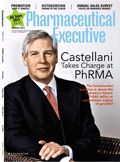Where have all the Scientists Gone?
With an emphasis on short-term objectives rather than long-term goals, pharma is missing a huge opportunity in applying market science to drive adherence
A $280 billion opportunity is left behind each year due to the failure of pharmaceutical companies to retain their customers. That's the equivalent of the combined total global revenue in 2009 for the top six pharmaceutical companies. For an individual pharmaceutical company, that's the equivalent of the cumulative lifetime revenue of launching a new blockbuster every year for the next 10 years. So why is this massive opportunity not managed with the same focused tenacity with which our pipelines are managed?

While advances in consumer science have blossomed, providing growth opportunities for savvy marketers, application has lagged as a tool for better adherence. (Getty Images / Stockbyte)
In the past several months in the pages of Pharm Exec, I've presented the argument that, while being very complex, the lost revenue from non-adherence can be systematically harnessed with principled resource allocation. In December 2010 (Pharm Exec), I introduced the concept of marketing programs that have a Mechanism of Action (MOA)—a concept we are very familiar with from the R&D side of the business. Within R&D, it is comforting (not to mention necessary) to be able to operate within a guiding framework that has been securely demonstrated, to not only provide appropriate boundaries for avenues of exploration, but to also provide a beacon of the path to success. In all, the supporting MOA provides the framework to shape developments towards fairly predictable outcomes that we can be somewhat confident will: A) lead to a positive risk/benefit offering towards improved patient health outcomes; B) provide additional needed armamentarium for physicians; and C) create an estimable and worthwhile return to the manufacturer.
What if we had this same navigational MOA to highlight our path in marketing? Do identifiable MOAs even exist in the commercial arena? If they did, would we have the desire, or the discipline, to stay within these prespecified boundaries?
Also in December, I presented a formulaic argument for non-adherence—one that is specified in mathematical terms using scientific principles of cognition. This essentially provides an MOA behind consumer decision-making and physician choice, something akin to the MOA that drug development scientists use prior to their avid pursuit of (and expenditure towards) drug development. This illustrates that scientific MOAs can indeed be generated to support a scientific approach to pharmaceutical marketing.
While significant advances in consumer science have continued to blossom and provide admirable growth opportunities for savvy marketers across diverse industries, the pharmaceutical industry has pretty much sat on the sidelines and watched this happen in the outside world. What's more is that industries that have been successful in this space are not nearly as sophisticated as pharma. So why hasn't the commercial side of the pharmaceutical industry paced itself with advances in consumer science? Or even just peeked over the wall at their internal R&D colleagues to gain some new processes that could potentially be applied to business? And why is such a richly scientific industry as pharma with so much to gain behind the curve, instead of leading the curve, in the science of marketing? Surely we have the intellect, the long-term tenure, the budgets, and we certainly have the need.
My prediction is that it will likely take another two or three years of running with unprincipled strategy before the industry cries out, "Enough! The mania has to stop!" And it will. Then, the reins will be picked up by their rightful owners: CEOs, CFOs, and executive VPs, who are currently standing back and watching as their marketing teams spin in ever frustrating circles, crippled by outdated business models. The problem is not that brand teams and middle management are not working hard enough, or smart enough—they are doing what they can, with the resources they are given, within the business framework they have to operate. I see the problem as two-fold: 1) there is a lack of ownership within top-tier management for scientific marketing models; and 2) there is an overemphasis on short-term quarterly objectives rather than the long-term goal. This has to change.
Harnessing the lost revenue from existing brands deserves the attention of upper management, executive directors, and shareholders. And it deserves a critical evaluation of where and why things are going wrong. Salvaging this revenue requires more than a new marketing strategy, it requires a new business model—one that is firmly rooted in scientific principles; one that can depict a formulaic MOA for consumer engagement and prescriber choices; one that can provide brand teams with the tools they need to securely set their strategy and direct their resources to initiatives that they know will have an impact. In essence, an MOA takes the guesswork out of budget planning, marketing program design, forecasting, and most importantly, harnesses lost revenue that our products were designed to deliver.
Dr. Andrea LaFountain is a Cognitive Scientist and CEO of Mind Field Solutions. She can be reached at andrea.lafountain@mind-field-solutions.com

The Misinformation Maze: Navigating Public Health in the Digital Age
March 11th 2025Jennifer Butler, chief commercial officer of Pleio, discusses misinformation's threat to public health, where patients are turning for trustworthy health information, the industry's pivot to peer-to-patient strategies to educate patients, and more.
Applying Porter’s Five Forces to Portfolio Management in Pharmaceutical R&D: A Strategic Roadmap
March 17th 2025The increasing costs and complexity of R&D in the pharmaceutical industry have necessitated the adoption of strategic portfolio management to optimize resource allocation and enhance competitive advantage.
Navigating Distrust: Pharma in the Age of Social Media
February 18th 2025Ian Baer, Founder and CEO of Sooth, discusses how the growing distrust in social media will impact industry marketing strategies and the relationships between pharmaceutical companies and the patients they aim to serve. He also explains dark social, how to combat misinformation, closing the trust gap, and more.